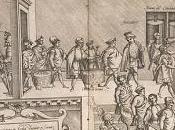
Chiunque ami la buona cucina, il primo impatto può indurre una potente salivazione, quasi al limite del pavloviano. Si avvia l'applicazione sullo smartphone, si preme un pulsante e dopo pochi secondi la piccola mappa su schermo si popola di foto. Tutte istantanee di cibo, in ogni sua forma. Primi piatti italiani, grigliate di carne, cucina orientale, street food, pizza. Molta pizza. Se il mondo fosse forchetta, canterebbe Cecco Angiolieri, questa sarebbe la sua pornografia. In realtà è solo l'ultima frontiera delle reti sociali.
Foodspotting 1, in inglese, significa più o meno "avvistare il cibo". E il social network omonimo, dedicato ai proprietari di smartphone con la passione per la cucina, fa esattamente questo: permette di vedere il cibo. Ma soprattutto di fotografarlo, in qualsiasi ristorante, pizzeria, tavola calda o chiosco del globo, e di condividerlo online, pronto per essere votato, commentato e, in ultima analisi, salivato dagli altri utenti.
L'idea di Foodspotting non è dissimile da quella dei più recenti social network fotografici, come Instagram 2, Path 3 o Piczl. Ma se su Instagram si condividono foto artistiche, su Foodspotting il tema esclusivo è la gastronomia. L'applicazione, che ha appena festeggiato un anno di vita, è disponibile su iPhone e Android, ma presto sbarcherà anche su BlackBerry. Ad oggi, si appoggia su un database di oltre mezzo milione
di foto, alimentato da una comunità di circa 800.000 utenti solo su iPhone. E dopo gli Stati Uniti, ha cominciato a diffondersi anche in Italia.
L'intuizione è di due ragazzi di San Francisco, Ted Grubb e Alexa Andrzejewski, che hanno costruito intorno al cibo una vera e propria esperienza sociale, sulla falsariga di quella di FourSquare e Gowalla, i social network dei luoghi. Ogni cibo può essere fotografato, geolocalizzato e votato, segnalandone la qualità con un'apposita coccarda. Accumulando segnalazioni di piatti è possibile guadagnare "distintivi" da esperto, da ostentare nel proprio profilo da gourmet. Il modo più veloce per assurgere alla fama è invece quello di creare una guida tematica, stilando il proprio elenco di cibi e ristoranti consigliati, che gli altri utenti potranno poi seguire (letteralmente) sulla mappa digitale.
E il gotha dell'alta cucina sembra aver raccolto con gusto l'invito, se è vero che tra le guide più seguite ci sono già quelle di alcune famose riviste o di chef di fama internazionale. Perché la gastronomia, in fondo, è prima di tutto una questione di fedeltà.
Social netfork. Foodspotting, in realtà, è solo il primo esperimento di successo nel campo delle food-community fotografiche. Ma come per ogni nuovo fenomeno in crescita, i concorrenti non si sono fatti attendere. È il caso di Chewsy 4, un'applicazione per smartphone sviluppata nel tempo libero da un piccolo gruppo di dipendenti Microsoft, ma che già ha raccolto un discreta community di appassionati negli Stati Uniti.
Anche in questo caso il cibo si fotografa e si condivide, ma a differenza di Foodspotting qui prevale l'approfondimento. In primo luogo, gli utenti sono invitati a scrivere recensioni più accurate, per non relegare la segnalazione all'invio di una foto. A ogni piatto, inoltre, è possibile assegnare un voto specifico (da uno a cinque cucchiai), esprimendo quindi anche giudizi negativi.
E la storia si ripete. Solo alcuni mesi fa, l'universo digitale aveva registrato il boom di Instagram, il social network della fotografia graziato da oltre un milione di iscritti dopo nemmeno tre mesi dal lancio. Un successo che aveva aperto il campo ad altri competitor, come l'ambizioso Path (una rete sociale volutamente ristretta agli amici più intimi), il discusso Color 5 (progettato per condividere le foto geograficamente) o il prossimo ZangZing. Ora tutto può essere replicato in chiave gastronomica. E gli smartphone, a quanto pare, stanno lasciando le strade per accomodarsi a tavola.
Buona giornata
Roberto
Anyone who loves good food, the first impact can induce salivation powerful, almost to the point of Pavlovian. You start the application on your smartphone, press a button and within seconds the little map on the screen is filled with photos. All snapshots of food, in all its forms. Italian pasta dishes, grilled meats, Asian cuisine, street food, pizza. A lot of pizza. If the world were fork, Cecco Angiolieri sing, this would be his pornography. In reality it is only the last frontier of social networks.
Foodspotting 1, in English, means something like "spot the food." And the eponymous social network, dedicated to the owners of smartphones with a passion for cooking, does exactly that: to see the food. But most of all to photograph at any restaurant, pizzeria, snack kiosk or the globe, and share online, ready to be voted, commented and, ultimately, salivation by other users.
The idea of Foodspotting is not unlike that of the latest social network cameras, as Instagram 2, 3 or Piczl Path. But if you share photos on Instagram artistic Foodspotting on the theme is the exclusive food. The application, which has just celebrated a year of life, is available on the iPhone and Android, but will arrive too soon to BlackBerry. To date, relies on a database of over half a million
photo, supplied by a community of about 800,000 users on the iPhone only. And after the United States, began to spread in Italy.
The intuition is two guys from San Francisco, Ted Grubb and Alexa Andrzejewski, who built around food a real social experience, similar to that of Foursquare and Gowalla, social networking sites. Any food can be photographed, Geolocation and voted, indicating the quality with a special rosette. Accumulating reports of dishes you can earn "badges" to be experienced to be shown off in your profile to gourmet. The quickest way to rise to fame is that instead of creating a thematic guide, to compile its own list of recommended foods and restaurants, that others will follow (literally) on the digital map.
And the who's who of haute cuisine seems to have picked up the call with taste, it is true that among the most popular guides there are already those of some famous magazines or internationally renowned chefs. Why is the food, after all, is primarily a question of loyalty.
Social netfork. Foodspotting, in reality, is only the first successful experiment in the field of food-photography community. But as with any new phenomenon on the rise, the competitors were not long in coming. This is the case Chewsy 4, an application designed for smartphones in their free time by a small group of Microsoft employees, but has already collected a discrete community of fans in the United States.
Again the food photographer and shares, but unlike Foodspotting deepening prevails here. First, users are encouraged to write reviews more accurate, not to relegate the message to sending a photo. Each dish is also possible to assign a specific rating (one to five tablespoons), then even expressing negative opinions.
And history repeats itself. Only a few months ago, the digital universe had registered the boom Instagram, the social network of the photograph graced by more than one million subscribers after less than three months after launch. This success opened up the field to other competitors, as the ambitious Path (a social network deliberately restricted to close friends), the controversial Color 5 (designed for sharing photos geographically) or the next ZangZing. Now everything can be replicated in key restaurant. And the smartphone, it seems, are leaving the streets to sit at the table.
Have a nice day
Roberto





